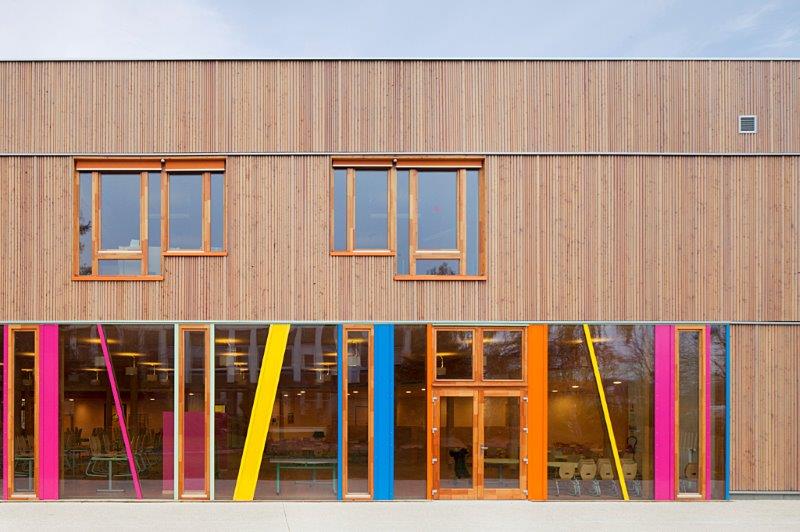Business and research join forces for a new education export product
Sustainable Education Design (SED) is a new Finnish education export concept that brings together some of the best partners in the fields of learning, building and sustainable energy solutions. SED is not only about education, but an overall education concept. It entails the what, the how and the where people learn and how sustainable the solutions are.
The SED project combines business models and concrete buildings and ICT solutions with continuous research and pedagogical development. This way, the parties benefit mutually from the development work.
The universities get real building projects that can be studied and co-created in a transdisciplinary process. The business partners get the most up-to-date know-how and research results that can be used for developing and improving their own concepts. The seamless collaboration creates value chains and networks that would be hard to achieve without such collaboration. The contacts also lead to direct customerships.
Turnkey solution for education export
Niclas Sandström is a teacher and doctoral student from the Research Group of Educational Psychology, led
by Professor Kirsti Lonka at the University of Helsinki. Sandström has been developing the concept and the resulting education export product since the beginning.
“The customer will be provided with an entire educational concept. It is based on human-centered design processes with pedagogy in the core through the whole process, sustainable and modular wooden building elements as well as energy solutions. It also includes an innovative, future-ready learning platform with its physical, virtual and social dimensions”.
“Trust within the team and between the partners is a critical success factor. A turnkey product sounds natural and practical, yet to achieve such a solution, the whole team has to be truly engaged and work for the common goal. The team members have to trust the different expertises that the partners have. This is often very difficult. Our conceptual development has already in the beginning phases surpassed these challenges”.
Some of the best Finnish partners in collaboration
University of Helsinki is responsible for the pedagogical design that is based on the latest results from learning research. Lappeenranta University of Technology leads the sustainability research and energy solutions. Tampere University of Technology is responsible for the product’s usability and architecture. The project is part of Tekes funded programme BEAM – Business with Impact.
“In the project we have very engaged business partners. Lenovo, Claned, Koulutus ja työnohjaus Talvio (Consulting and Training Talvio), Elementit-E, Green Energy Finland, and Suomen Yliopistokiinteistöt (University Properties of Finland Ltd), representing all the key segments of an overall concept.
As architect, the project has Olavi Koponen, who apart from having a renowned international career in wood architecture is also passionate about pedagogy and excelling learning environments”.
Global markets
In the first phases of the project, the customers come from the public sector, including associations. Collaboration has been discussed with several organisations. The product will first be tested and piloted using rapid prototyping and gathering user experiences. The goal is to get customers nationally and internationally, producing this way business opportunities for Finnish companies in the field of education.
For example EK (Confederation of Finnish Industries) has for long promoted the idea of including education also in the toolkit for developmental aid. SED can offer solutions for measuring and validating the developmental effect of educational enterprises.
“SED will produce a new kind of tool for measuring and finding informative indicators. The new measure could be called a ROI scale of Sustainable Education”, Sandström explains. “The tool can be used for measuring and estimating the developmental effectivity of education and educational interventions and for validating them in a pre-post test setting. This way, investment in education needn’t be made blindly”.
The end of poor ambient air quality in schools
The concept raises attention both nationally and internationally. Several Finnish cities have approached the SED team and expressed their interest in being part in the development and building of schools that are designed and built according to the SED principles. In numerous educational facilities, people suffer from poor ambient air quality and dysfunctional building solutions.
“We find it’s a human right to be able to work and learn in a healthy and modern learning environment. For instance, our building partner has lately built a new modular wooden school building on a very tight schedule. It’s modular and moveable, yet still a completely normal building with all the facilities”.
“The school can be used as a platform to study and validate different SED-related indicators and ideas. Our aim is to pilot the overall solution with a suitable partner city or a network of cities, continuously learning and developing the concept”, Sandström says.
Aiming for a bigger scale
“We will build a solid Proof of Concept in Finland, which gives us a basis for international customerships. A turnkey solution enables different kinds of orders of varying scales. We aim at being an internationally recognised Finnish service provider”.
Openness and interest as guiding principles
The SED homepage presents the key segments of the project, the partners and ongoing processes. It’s a platform for updates, sharing of knowledge, research results and pieces of news from around the world. The homepage is a window to how sustainable educational solutions develop and what can be learned from them.
“We have already started building a network, and even collaborators that haven’t been in the project from its start have joined our activities. We would like to welcome different cities, authorities and teachers to participate in our network with a desire to create the world’s best school, the School of all schools”, Sandström concludes.
More about Sustainable Education Design (SED): http://educationdesign.fi/
English translation: Niclas Sandström

